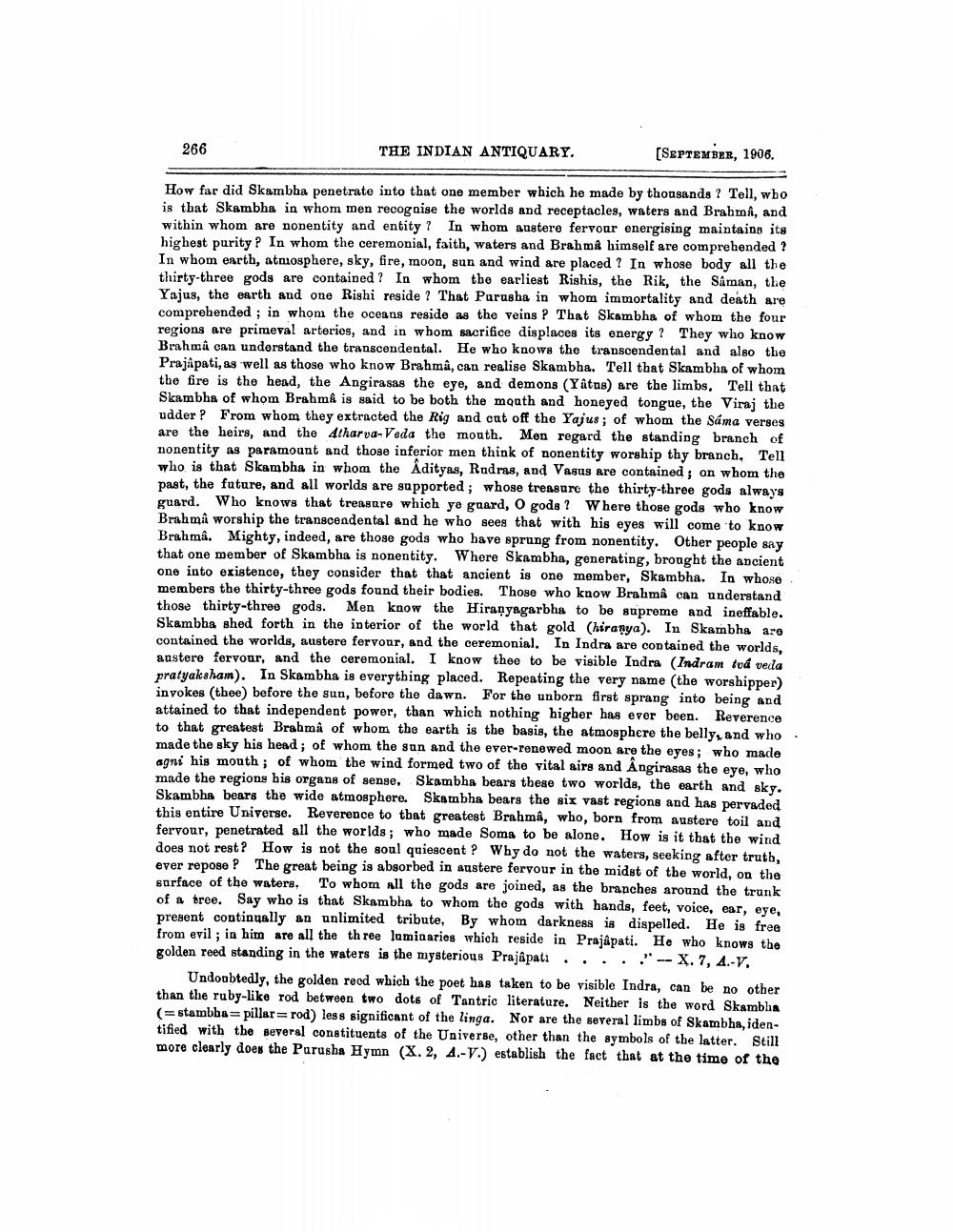________________
266
THE INDIAN ANTIQUARY.
SEPTEMBER, 1906.
How far did Skambha penetrate into that one member which he made by thousands ? Tell, who is that Skambha in whom men recognise the worlds and receptacles, waters and Brahmâ, and within whom are nonentity and entity? In whom austere fervour energising maintains its highest purity ? In whom the ceremonial, faith, waters and Brahmå himself are comprehended ? In whom earth, atmosphere, sky, fire, moon, sun and wind are placed ? In whose body all the thirty-three gods are contained ? In whom the earliest Rishis, the Rik, the Saman, the Yajus, the earth and one Rishi reside? That Parusha in whom immortality and death are comprehended ; in whom the oceans reside as the veins ? That Skambha of whom the four regions are primeval arterios, and in whom sacrifice displaces its energy? They who know Brahmâ can understand the transcendental. He who knows the transcendental and also the Prajapati, as well as those who know Brahmâ, can realise Skambha. Tell that Skambha of whom the fire is the head, the Angirasas the eye, and demons (Yâtus) are the limbs. Tell that Skambha of whom Brahma is said to be both the mouth and honeyed tongue, the Viraj the udder? From whom they extracted the Rig and cut off the Yajus; of whom the Sáma verges are the heirs, and the Atharva-Veda the mouth. Mon regard the standing branch of nonentity as paramount and those inferior men think of nonentity worship thy branch, Tell who is that Skambha in whom the Adityas, Rodras, and Vagus are contained ; on whom the past, the future, and all worlds are supported; whose treasure the thirty-three gods always guard. Who knows that treasure which ye guard, O gods? Where those gods who know Brahma worship the transcendental and he who sees that with his eyes will come to know Brahma. Mighty, indeed, are those gods who have sprung from nonentity. Other people say that one member of Skambha is nonentity. Where Skambha, generating, brought the ancient one into existence, they consider that that ancient is one member, Skambha. In whose members the thirty-three gods found their bodies. Those who know Brahmâ can understand those thirty-three gods. Men know the Hiranyagarbha to be supreme and ineffable. Skambha shed forth in the interior of the world that gold (hiranya). In Skambha are contained the worlds, austere fervour, and the ceremonial. In Indra are contained the worlds, aastere fervour, and the ceremonial. I know thee to be visible Indra (Indram frá vedla pratyaksham). In Skambha is everything placed. Repeating the very name (the worshipper) invokes (thee) before the sun, before the dawn. For the unborn first sprang into being and attained to that independent power, than which nothing higher has ever been. Reverence to that greatest Brahmâ of whom the earth is the basis, the atmosphere the belly, and who. made the sky his head; of whom the gun and the ever-renewed moon are the eyes; who made agni his mouth; of whom the wind formed two of the vital airs and Angirasas the eye, who made the regions his organs of senge, Skambha bears these two worlds, the earth and sky. Skambha bears the wide atmosphere. Skambha bears the six vast regions and has pervaded this entire Universe. Reverence to that greatest Brahmâ, who, born from austere toil and fervour, penetrated all the worlds; who made Soma to be alone. How is it that the wind does not rest? How is not the soul quiescent ? Why do not the waters, seeking after truth, ever reposo P The great being is absorbed in austere fervour in the midst of the world, on the surface of the waters. To whom all the gods are joined, as the branches around the trunk of a tree. Say who is that Skambha to whom the gods with hands, feet, voice, ear, eye, present continually an unlimited tribute, By whom darkness is dispelled. He is free from evil; in him are all the three laminaries which reside in Prajapati. He who knows the golden reed standing in the waters is the mysterious Prajapati ....." --X. 7, 4.-v.
Undoubtedly, the golden reod which the poet has taken to be visible Indra, can be no other than the ruby-like rod between two dots of Tantric literature. Neither is the word Skamblis (=stambba=pillar=rod) less significant of the linga. Nor are the several limbs of Skambha, identified with the several constituents of the Universe, other than the symbols of the latter. Still more clearly does the Purusha Hymn (X. 2, A.-V.) establish the fact that at the time of the




